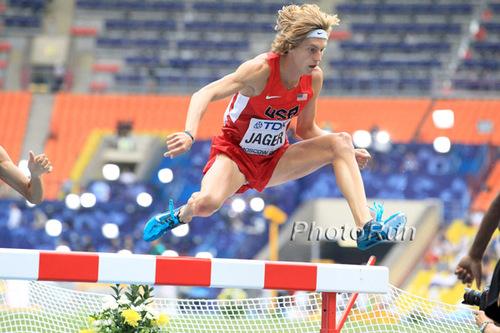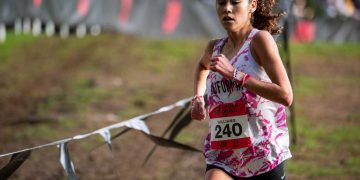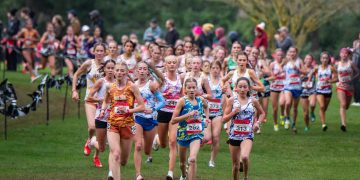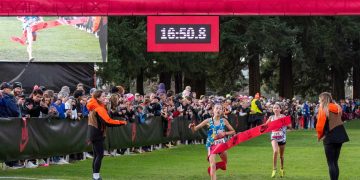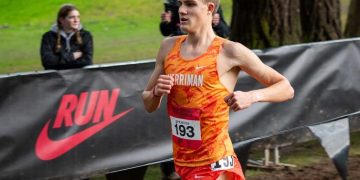RelatedPosts
The Dominating Force That Is Evan Jager
By Cait Chock
Evan Jager is an animal. Wild blonde mane blowing behind him as he charges down the home stretch, to watch Evan Jager run is to watch a lion dominating the track. This animal is at home, ruling the terrain he was he was born for.
“We really got spoiled with Evan, and we [Jerry and I] both acknowledge that and realize it’s unlikely to ever happen again with another athlete learning the event so fast,” shares Bowerman Track Club steeplechase coach, Pascal Dobert. “He’s very coachable and extremely talented, and that’s a lethal combination.” Though don’t be fooled, a genetic predisposing for greatness is utterly useless without the work ethic to match. To truly rule one must also possess a ferocious drive.
Jager showed right away that he was fast, no question there; he’d thrown himself in amongst the best straight out of high school. With teammates like Chris Solinsky, Matt Tegenkamp, and Simon Bairu pushing the pace, it was a matter of survival. Undaunted, Jager eagerly chose to one-up survival and thrive, immediately making two IAAF World Championship teams and turning professional between that time.
When Jager first debuted in the steeplechase in 2012, his 8:26 was shockingly superb. Still, some questioned the reasoning behind him making the move. The steeplechase has progressed exponentially over the past decades, but at the same time one could argue that Jager possessed just as much ability to win the more ‘media-hyped’ flat distances. What those left wondering didn’t know was what Jager’s coaches, Jerry Schumacher and Dobert knew. More correctly what they’d already seen in practice. Jager could win in a given flat race, he could dominate in a steeple race. Jager gave the media a reason to draw focus to the steeple.
“The first thing that goes [in a steeplechase] when you’re really fatigued is the ability to concentrate, and it requires a lot of practice to hurdle efficiently when you’re really tired,” explains Dobert. “In a flat race, if you’re on the ropes and just hanging on by a thread, you put your head down and grind out the last few laps. You can’t do that in a steeple. There’s a lot more going on. That’s partly why some athletes just can’t run the steeple even though they may be really fast on the flat.”
Jager has the focus, the ability to will his body past the realms of what it may be naturally predisposed to do. The focus to abuse it and eke out every last bit. Genetics will only get you to a point, one’s will dictates the rest. Mere months after his first steeple race Jager blew the field away in winning the 2012 US Olympic Trials. In July of 2012 he set the American Record in 8:06.81.
Pascal can speak from personal experience; he was the dominating force in the steeplechase event across the late-90’s and ushering in the new millennia. Who better to coach Jager to lowering his own American Record than the man who was once on top of the Nation’s steeplechase himself?
“It’s been great watching the event progress the last few years. Hopefully we can get to a point in the US where we have more than a few guys consistently run well below 8:20. I think sub-8:20 is the benchmark for whether you’re serious in the event, and the more US guys we have under that the better.” Dobert has played a dual role in progressing the event, first as an athlete and now as a coach. Pascal won the 1998-99 USA Track and Field Championships and in 2000 won the US Olympic Trials, setting a PR of 8:15.77 in the process.
Will and focus aside, there are physicalities that make the steeple a difficult event to truly take to, one would be remiss to assume the transition is always so seamless. “Well you need to work on hurdling and water jumping obviously, and put yourself in a position in practice where you’re having to do those things fatigued.” What enables a runner to execute successful hurdling on the track begins in the strength training room. One must be strong and supple enough to be both efficient and avoid getting injured. “Core and strength work is very important for any event, but especially in the steeple. There’s a lot of abuse your body has to absorb during a race.”
We may never see someone with a learning curve quite as dramatic as Jager’s, but Dobert professes that a runner who is truly dedicated to steeple-specific training will improve. Read this as incentive for other runners to perhaps embark on creating the depth Dobert spoke of. “If you train for the event properly, the difference in how you feel at the end of a flat race and a steeple is negligible.” The end of every race hurts like a beast.
When Dan Huling joined the group in 2013, Jager was no longer alone in his steeplechase-focused work. “Dan came in with a lot of experience, so there were just small refinements we worked on with him,” explains Dobert. Huling experienced rapid improvement right away. “The main thing with Dan initially was making him a better athlete, stronger and more fit. He’s a lot more consistent now.”
Without a World Championships or Olympics to focus on in 2014, many athletes took to improving on times or race tactics. For the Bowerman Track Club athletes, “We [are just focusing] on being competitive in races in Europe.” Their summer was split up into two European racing seasons with a training block in St. Mortiz between them. The latter half was kicked off August 23rd with a 1500m in Merksem, Belgium. In far from ideal conditions Jager took third (3:39.68) behind teammate Ryan Hill (3:39.53) and Lawli Lalang (3:38.93). Successful tune-up after weeks spent training at altitude, Jager and his teammates’ sights are set next on Brussels. With the first part of Jager’s track season seeing him a scant 0.16 shy of his American Record, even in this non-Championship year fans await in eager anticipation for what he has yet to show us.
“Between now and Rio we just focus on improving as athletes, it’s as simple as that,” states Dobert. “There are so many different facets of life as a professional athlete, there are always ways to improve and things you can do to make yourself better.”
A lion never settles. Evan Jager is an animal, born to run, let no one stand in his way.
———————–
Caitlin Chock (caitchock.com) set the then National High School 5k Record (15:52.88) in 2004 and previously ran for Nike. A freelance writer, artist, and designer she writes about all things running and founded Ezzere, her own line of running shirts (www.ezzere.com). You can read more, see her running comics, and her shirts at her website.
Author
-

Larry Eder has had a 52-year involvement in the sport of athletics. Larry has experienced the sport as an athlete, coach, magazine publisher, and now, journalist and blogger. His first article, on Don Bowden, America's first sub-4 minute miler, was published in RW in 1983. Larry has published several magazines on athletics, from American Athletics to the U.S. version of Spikes magazine. He currently manages the content and marketing development of the RunningNetwork, The Shoe Addicts, and RunBlogRun. Of RunBlogRun, his daily pilgrimage with the sport, Larry says: "I have to admit, I love traveling to far away meets, writing about the sport I love, and the athletes I respect, for my readers at runblogrun.com, the most of anything I have ever done, except, maybe running itself." Also does some updates for BBC Sports at key events, which he truly enjoys.
Theme song: Greg Allman, " I'm no Angel."
View all posts


